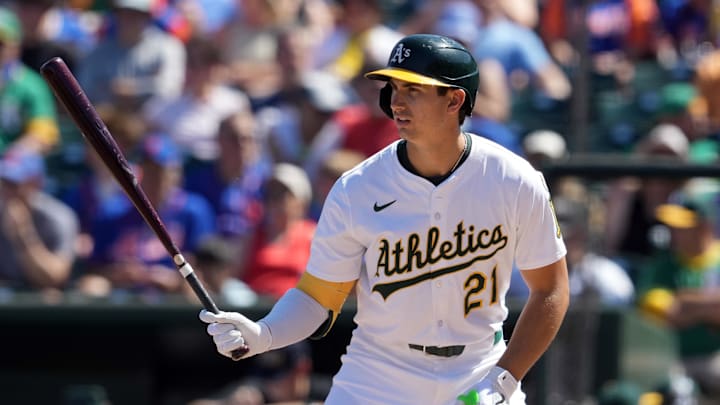On Wednesday, the Athletics called up top prospect Nick Kurtz just nine months after drafting him fourth overall in the 2024 Amateur Draft. Kurtz only has 32 minor league games under his belt, but his robust .321/.385/.655 slash line (batting average (AVG), on-base percentage (OBP), slugging percentage (SLG)) at AAA so far this season has the organization convinced he’s ready to be a big league first baseman.
The problem: they’ve already got a first baseman lighting the league on fire.
Breaking down Tyler Soderstrom’s hot start in 2025
Heading into this season, Tyler Soderstrom’s forecast for major league success was murky at best. A first-round draft pick in 2020 as a well-regarded high school catcher, Soderstrom’s defensive shortcomings necessitated a removal of the catcher’s gear earlier into his career than the A’s likely envisioned. He caught only four MLB innings last season and doesn’t seem in line to pick many up this season.
Soderstrom’s potential has always hinged on his offense, though, so his defensive drawbacks haven’t stopped the rebuilding Athletics from providing an extended run in the bigs. After a dismal 45-game rookie year in 2023, he took a step forward last year but missed two months with a left wrist bone bruise. When healthy, his .743 on-base plus slugging (OPS) was better than his .472 clip in 2023 but was nothing special for a first baseman.
That forward progress has now accelerated in the early goings of 2025. The following graphic summarizes his performance this season using a project of mine called LASR (League-Adjusted Standardized Rating) which places all stats onto the same 20-80 scouting scale based on league qualifiers (all data is sourced from FanGraphs). A 50 grade is average and every 10 points in either direction is one standard deviation.
Soderstrom had previously shown power in the minors, posting isolated power (ISO) values of .234, .275, and .328 in 2022-2024 respectively. However, outside of a stretch in June last year where he hit six home runs in 17 games, that power hadn’t yet translated to the majors, with a .150 ISO and a pedestrian 12 long balls across 106 career MLB games coming into 2025.
The Athletics hoped for another step up this year, but even they couldn’t have expected the power surge Soderstrom immediately burst out of the gate with. He hit two home runs on Opening Day and has since added seven more, including two more games with multiple homers that made him only the fifth player in MLB history with three multi-HR performances within the first 17 games of the season.
His total of nine is currently tied for the major league lead, and he is one of only three qualified players (alongside Cal Raleigh and Kyle Manzardo) with a home run percentage (HR%) LASR grade of 75. His enhanced fence-clearing ability has been backed up by excellent batted ball data, with Barrel%, exit velocity (EV), and Hard% LASR grades all at least one standard deviation above league average.
The significant upticks in those measurements since last year serve as evidence that his early season success is at least somewhat sustainable. Along with advances in solid contact, he has made great strides at hitting the ball in the air. Over his three MLB seasons, his average launch angle (LA) has now risen from 5.7 to 9.6 to 13.4 while his fly ball percentage (FB%) has increased from 30.1% to 38.0% to 43.2%.
He has benefitted from a little luck in sneaking balls over the fence in 2025, with only 7.9 expected home runs (xHR). However, the rest of his expected stats are right in line with his results: .292/.290 batting average/expected batting average (AVG/xAVG), .615/.610 slugging percentage/expected slugging percentage (SLG/xSLG), and .414/.404 weighted on-base average/expected weighted on-base average (wOBA/xwOBA).
These offensive gains are not limited to just bashing the ball. He has also been more selective with his swing decisions and has seen better contact rates as a reward. His chase, whiff, and strikeout rates have dropped while his contact and walk rates have trended up. Every aspect of his offensive profile has moved in the right direction, and it’s looking like the A’s have another truly dominant force in their lineup.
As the next great Athletics team slowly takes its shape, however, they now face a conundrum. Kurtz made his MLB debut on Wednesday at first base. With established veteran Brent Rooker firmly holding down the DH spot, Soderstrom will need to make another position change to accommodate Kurtz’s arrival. This transition began Wednesday, when Soderstrom played his first professional innings in the outfield.
Soderstrom has not been a good defender at first, so the A’s aren’t conceding defensive value by moving him off the position. His arm has been considered above average since he was a prospect and his sprint speed is impressive for a former catcher, so he might succeed in the outfield. However, there is certainly a risk in forcing a sudden brand-new position change on a player in the midst of a breakout season.
The Athletics have boasted a surprisingly adept offense thus far in 2025, currently sporting a 116 wRC+ that is fourth-best in MLB, and Soderstrom has been the main contributor. Remarkably, he is still only 23 years old, so even though his spot on the field may be a question mark moving forward, there are high hopes that this scorching start could signify the mere dawn of Tyler Soderstrom’s future stardom.
